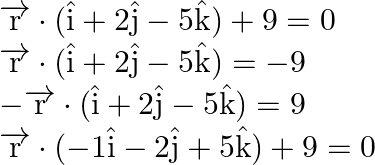Solution:
The vector eq. of a line passing through a point with position vector ![]() and parallel to vector
and parallel to vector ![]() is given as
is given as
![]()
Given that the line passes through ![]()
Therefore, ![]()
Let’s find the normal of plane

Now compare it with ![]()
![]()
As line is perpendicular to plane, the line will be parallel of the plane
![]()
Therefore,

As a resullt, the required vector equation of line is ![]()
